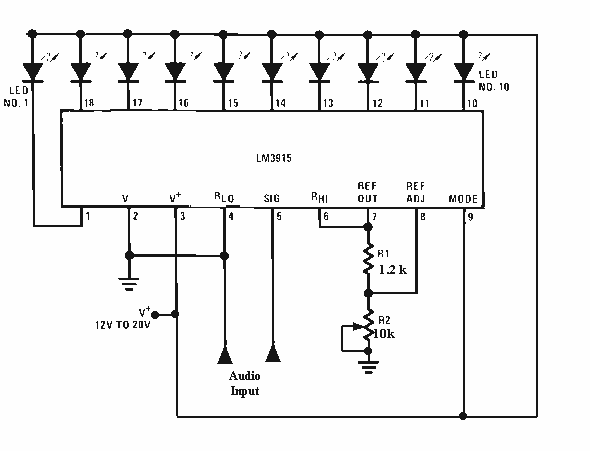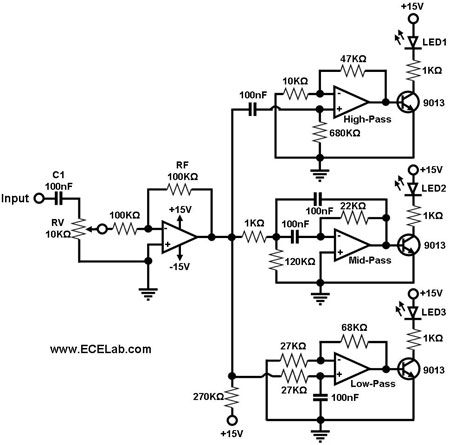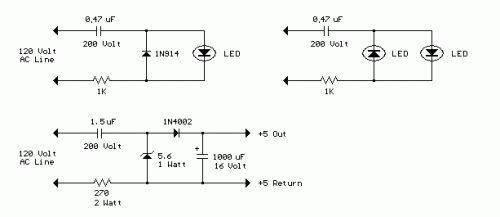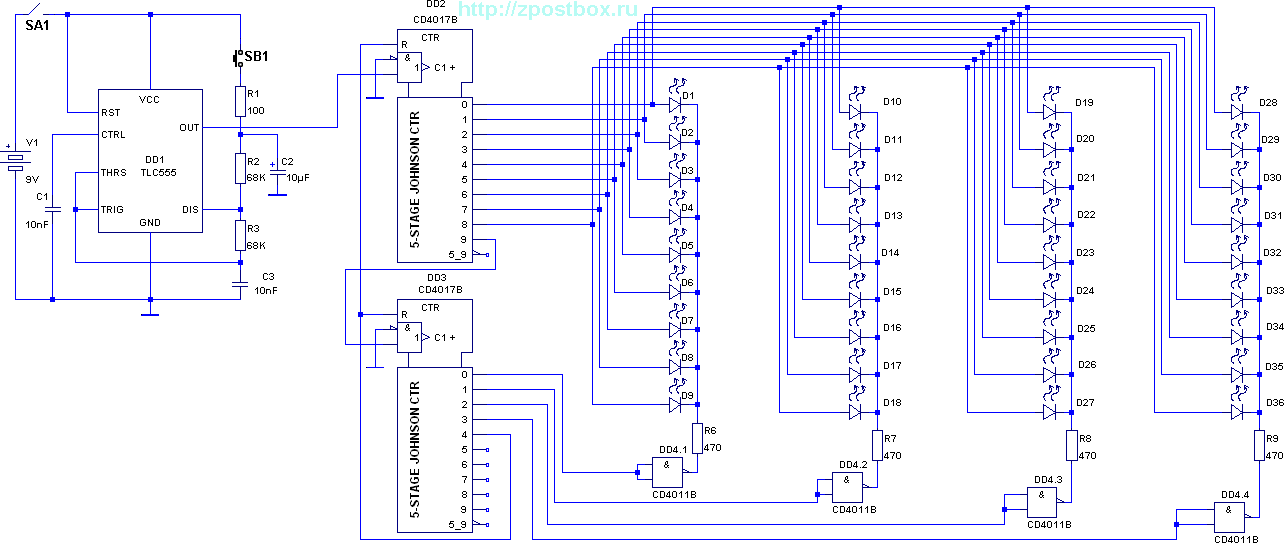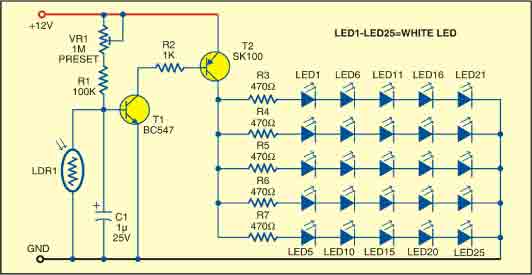
Dancing LEDs
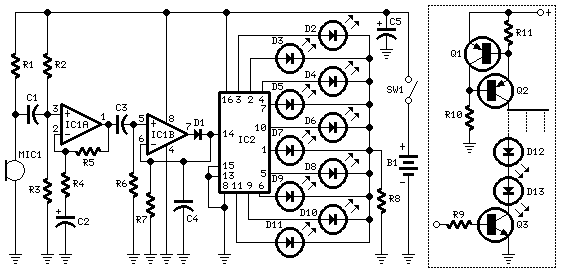
The basic circuit illuminates up to ten LEDs in sequence, synchronized with the rhythm of music or speech detected by a small microphone. The expanded version can drive up to ten strips, each containing up to five LEDs, powered by a 9V supply. IC1A amplifies the audio signal from the microphone by approximately 100 times and drives IC1B, which functions as a peak voltage detector. The output peaks of IC1B are synchronized with the input signal peaks, which in turn clock IC2, a ring decade counter capable of sequentially driving up to ten LEDs. An additional circuit allows for the driving of up to ten LED strips, each consisting of five LEDs (maximum), at a 9V supply. This circuit includes a 10mA constant current source (Q1 and Q2) that is shared among all LED strips and a switching transistor (Q3) that drives a strip composed of 2 to 5 series-connected LEDs. Consequently, one transistor and its base resistor are needed for each strip utilized. When employing the additional circuit, only one instance of R10, R11, Q1, and Q2 is necessary to drive up to ten LED strips. Conversely, one instance of R9 and Q3 is required for each strip in use. To utilize a smaller number of LEDs or LED strips, pin #15 of IC2 should be disconnected from ground and connected to the first unused output pin. For those wishing to use a wall-plug transformer instead of a 9V battery, the circuit can be powered at 12V, allowing for the use of up to 6 LEDs per strip, or at 15V, permitting the use of up to 7 LEDs per strip.
The circuit operates by detecting audio signals through a microphone, which is amplified by IC1A. This amplification is crucial for ensuring that even low-level audio signals can effectively trigger the LED illumination. The amplified signal is processed by IC1B, which detects the peaks of the audio waveform. These peaks are essential for timing the illumination of the LEDs, as they correspond to the beats or significant moments in the audio being played.
IC2, the ring decade counter, is responsible for sequencing the LEDs. It receives clock signals from IC1B, which synchronizes the LED illumination with the detected audio peaks. The counter allows for a sequential lighting pattern, making the visual output dynamic and engaging.
The additional circuit that drives the LED strips utilizes a constant current source design, which is advantageous for maintaining consistent brightness across multiple LEDs. Q1 and Q2 work together to provide a stable 10mA current to the LED strips, ensuring that the LEDs operate within their specified current ratings, thereby prolonging their lifespan and maintaining uniform brightness.
The switching transistor Q3 is pivotal in controlling the operation of each LED strip. By allowing for the connection of multiple LEDs in series, the design can accommodate different configurations based on user preference. The ability to adjust the number of LEDs per strip by changing the power supply voltage introduces flexibility, making the circuit suitable for various applications, whether powered by a battery or a wall transformer.
In summary, this circuit design not only provides an entertaining visual display synchronized with audio but also offers versatility in terms of LED configuration and power supply options, making it a valuable project for electronics enthusiasts and professionals alike.The basic circuit illuminates up to ten LEDs in sequence, following the rhythm of music or speech picked-up by a small microphone. The expanded version can drive up to ten strips, formed by up to five LEDs each, at 9V supply. IC1A amplifies about 100 times the audio signal picked-up by the microphone and drives IC1B acting as peak-voltage detector
. Its output peaks are synchronous with the peaks of the input signal and clock IC2, a ring decade counter capable of driving up to ten LEDs in sequence. An additional circuit allows the driving of up to ten strips, made up by five LEDs each (max. ), at 9V supply. It is formed by a 10mA constant current source (Q1 & Q2) common to all LED strips and by a switching transistor (Q3), driving a strip obtained from 2 to 5 series-connected LEDs.
Therefore one transistor and its Base resistor are required to drive each strip used. Adopting the additional circuit, only one item for R10, R11, Q1 and Q2 is required to drive up to ten LED strips. On the contrary, one item of R9 and Q3 is necessary to drive each strip you decided to use. Whishing to use a lower number of LEDs or LED strips, pin #15 of IC2 must be disconnected from ground and connected to the first unused output pin.
Example: Whishing to use a wall-plug transformer-supply instead of a 9V battery, you can supply the circuit at 12V, allowing the use of up to 6 LEDs per strip, or at 15V, allowing the use of up to 7 LEDs per strip. 🔗 External reference
The circuit operates by detecting audio signals through a microphone, which is amplified by IC1A. This amplification is crucial for ensuring that even low-level audio signals can effectively trigger the LED illumination. The amplified signal is processed by IC1B, which detects the peaks of the audio waveform. These peaks are essential for timing the illumination of the LEDs, as they correspond to the beats or significant moments in the audio being played.
IC2, the ring decade counter, is responsible for sequencing the LEDs. It receives clock signals from IC1B, which synchronizes the LED illumination with the detected audio peaks. The counter allows for a sequential lighting pattern, making the visual output dynamic and engaging.
The additional circuit that drives the LED strips utilizes a constant current source design, which is advantageous for maintaining consistent brightness across multiple LEDs. Q1 and Q2 work together to provide a stable 10mA current to the LED strips, ensuring that the LEDs operate within their specified current ratings, thereby prolonging their lifespan and maintaining uniform brightness.
The switching transistor Q3 is pivotal in controlling the operation of each LED strip. By allowing for the connection of multiple LEDs in series, the design can accommodate different configurations based on user preference. The ability to adjust the number of LEDs per strip by changing the power supply voltage introduces flexibility, making the circuit suitable for various applications, whether powered by a battery or a wall transformer.
In summary, this circuit design not only provides an entertaining visual display synchronized with audio but also offers versatility in terms of LED configuration and power supply options, making it a valuable project for electronics enthusiasts and professionals alike.The basic circuit illuminates up to ten LEDs in sequence, following the rhythm of music or speech picked-up by a small microphone. The expanded version can drive up to ten strips, formed by up to five LEDs each, at 9V supply. IC1A amplifies about 100 times the audio signal picked-up by the microphone and drives IC1B acting as peak-voltage detector
. Its output peaks are synchronous with the peaks of the input signal and clock IC2, a ring decade counter capable of driving up to ten LEDs in sequence. An additional circuit allows the driving of up to ten strips, made up by five LEDs each (max. ), at 9V supply. It is formed by a 10mA constant current source (Q1 & Q2) common to all LED strips and by a switching transistor (Q3), driving a strip obtained from 2 to 5 series-connected LEDs.
Therefore one transistor and its Base resistor are required to drive each strip used. Adopting the additional circuit, only one item for R10, R11, Q1 and Q2 is required to drive up to ten LED strips. On the contrary, one item of R9 and Q3 is necessary to drive each strip you decided to use. Whishing to use a lower number of LEDs or LED strips, pin #15 of IC2 must be disconnected from ground and connected to the first unused output pin.
Example: Whishing to use a wall-plug transformer-supply instead of a 9V battery, you can supply the circuit at 12V, allowing the use of up to 6 LEDs per strip, or at 15V, allowing the use of up to 7 LEDs per strip. 🔗 External reference
Warning: include(partials/cookie-banner.php): Failed to open stream: Permission denied in /var/www/html/nextgr/view-circuit.php on line 713
Warning: include(): Failed opening 'partials/cookie-banner.php' for inclusion (include_path='.:/usr/share/php') in /var/www/html/nextgr/view-circuit.php on line 713
